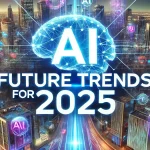
The Ubiquity of AI: A Transformative Force Across Industries
The Ubiquity of AI: Transforming Industries & Redefining the Future
Explores the pervasive impact of Artificial Intelligence across various industries, highlighting real-world applications, potential challenges, and the future of work in an AI-driven world.
Imagine strolling into a coffee shop that remembers your usual order, or a financial advisor that perfectly customizes your investment plan based on data-driven insights. These aren’t fantasies; they’re the outcomes of AI integration within various sectors. As technology rapidly evolves, AI’s influence is unsettlingly expansive, reshaping how industries operate and interact with consumers.
Revolutionizing Customer Experience
In today’s fast-paced world, businesses are constantly seeking ways to enhance customer experience. One of the most significant advancements in this area is the use of artificial intelligence (AI). AI is not just a buzzword; it is reshaping how companies interact with their customers. This section explores how AI is revolutionizing customer experience through three key areas: personalization, chatbots, and predictive analytics.
Personalization Through Data Analytics
Personalization is at the heart of modern customer engagement. Companies are leveraging data analytics to tailor experiences to individual preferences. But what does this mean? It means using information about customers—like their past purchases, browsing habits, and even social media activity—to create a unique shopping experience.
- 35% of consumers prefer personalized shopping experiences.
- AI-driven personalization can lead to increased customer loyalty.
For instance, companies like Amazon and Netflix have mastered this art. They analyze user behavior to recommend products or shows that align with individual tastes. This not only enhances user satisfaction but also drives sales. Imagine walking into a store where every item is tailored to your liking. That’s the power of personalization.
AI Chatbots Enhancing Service Efficiency
Another game-changer in customer experience is the introduction of AI chatbots. These virtual assistants can handle a staggering 80% of customer inquiries. They are available 24/7, providing instant responses to customer questions. This is a significant improvement over traditional customer service methods.
Think about it: how often have you waited on hold for a customer service representative? With chatbots, those days are fading. They can answer common questions, guide users through processes, and even resolve issues without human intervention. This not only saves time for customers but also allows human agents to focus on more complex inquiries.
Predictive Analytics for Understanding Customer Preferences
Predictive analytics is another powerful tool in the AI arsenal. It involves using historical data to forecast future customer behavior. By analyzing patterns, businesses can anticipate what customers might want next. This proactive approach allows companies to tailor their offerings accordingly.
- For example, if a customer frequently buys running shoes, predictive analytics can suggest related products like athletic wear or accessories.
- This not only enhances the shopping experience but also increases the likelihood of additional sales.
In essence, predictive analytics transforms the way businesses interact with their customers. It shifts the focus from reactive to proactive, ensuring that customers feel understood and valued.
“Personalization is not a trend; it’s the future of business.” – Jay Baer
This quote encapsulates the essence of modern customer experience. Personalization is no longer just a nice-to-have; it is a necessity. Customers expect businesses to understand their needs and preferences. Those that fail to adapt may find themselves left behind.
AI is revolutionizing customer interactions by providing personalized experiences and insights. As technology continues to evolve, the potential for enhancing customer experience will only grow. Companies that embrace these changes will likely lead the way in customer satisfaction and loyalty.
Redefining Workforce Dynamics
The landscape of work is changing rapidly. At the center of this transformation is artificial intelligence (AI). AI tools are not just buzzwords; they are reshaping how businesses operate and how employees perform their tasks. The integration of AI is enhancing worker efficiency, but it also raises important questions about job security and the future of work.
AI Tools Improving Productivity
According to recent data, 82% of businesses report increased productivity with the adoption of AI tools. This is not surprising. AI can automate repetitive tasks, analyze vast amounts of data quickly, and provide insights that humans might miss. For example, AI can handle customer inquiries through chatbots, allowing human employees to focus on more complex issues.
Imagine a world where mundane tasks are taken care of by machines. This frees up time for employees to engage in creative problem-solving or strategic planning. It’s like having a personal assistant who never tires. But how does this affect the workforce? Are we looking at a future where humans are sidelined?
Human-AI Collaboration in Tasks
Rather than replacing humans, AI is designed to work alongside them. This collaboration can lead to better outcomes. For instance, in healthcare, AI can assist doctors by providing diagnostic suggestions based on patient data. This partnership can enhance decision-making and improve patient care.
Moreover, AI can help identify skills gaps in the workforce. By analyzing performance data, organizations can tailor training programs to equip employees with the necessary skills for the future. This is crucial as the nature of work evolves. It’s not just about using AI; it’s about leveraging it to enhance human capabilities.
Job Displacement Concerns vs. Job Evolution
Despite the benefits, there are valid concerns about job displacement. A staggering 15 million jobs are expected to be displaced by AI by 2030. This statistic can be alarming. However, it’s essential to consider the flip side. While some jobs may disappear, new ones will emerge, often requiring different skills.
The question remains: how can workers adapt? The key lies in continuous learning. As industries evolve, so must the workforce. Upskilling and reskilling will be vital. Workers need to embrace change and seek opportunities to learn new technologies. This adaptability can turn potential threats into opportunities.
“The question is not whether AI will take jobs, but rather how it will change the nature of work itself.” – Andrew McAfee
This quote encapsulates the essence of the current workforce dynamics. It’s not just about job loss; it’s about understanding how work will transform. The future of work is an evolving frontier where AI and humans must work collaboratively for optimal results.
In conclusion, the integration of AI into the workplace is a double-edged sword. On one hand, it boosts productivity and enhances collaboration. On the other, it raises concerns about job security. The challenge lies in navigating this new landscape. Organizations and employees alike must be proactive in adapting to these changes.
As we move forward, the focus should be on harnessing the power of AI while ensuring that the workforce is prepared for the changes ahead. The future is not just about technology; it’s about people and how they can thrive in a world where AI plays an increasingly significant role.
Navigating Ethical Considerations in AI Implementation
As artificial intelligence (AI) continues to evolve, ethical considerations have taken center stage. The implementation of AI technology raises questions about bias, transparency, and regulation. These issues are not just theoretical; they have real-world implications that affect individuals and society at large.
Understanding Bias in AI Algorithms
Bias in AI algorithms is a pressing concern. Algorithms are designed to make decisions based on data. However, if the data used to train these algorithms is biased, the outcomes will also be biased. This can lead to unfair treatment in various sectors, such as hiring, lending, and law enforcement.
For instance, a hiring algorithm trained on historical data may favor candidates from certain demographics while overlooking equally qualified individuals from other backgrounds. This raises the question: how can we trust AI to make fair decisions if it is built on biased foundations?
Reports indicate that bias has been found in decision-making algorithms across multiple industries. This highlights the urgent need for accountability in AI development. Developers must actively work to identify and mitigate bias in their systems. They should ask themselves: what steps can be taken to ensure fairness in AI?
The Importance of Transparency in AI Decision-Making
Transparency is another critical aspect of ethical AI implementation. When AI systems make decisions, stakeholders deserve to understand how those decisions are made. This is particularly important in sectors like healthcare and criminal justice, where lives can be significantly impacted.
Imagine a patient being denied treatment based on an algorithm’s decision. If the patient does not understand why this decision was made, it can lead to distrust in the healthcare system. Transparency fosters trust. It allows individuals to question and understand the processes behind AI decisions.
To enhance transparency, organizations should provide clear explanations of how their AI systems function. This could involve publishing the criteria used in decision-making or allowing audits of the algorithms. As Timnit Gebru wisely stated,
“With great power comes great responsibility; this is especially true in the realm of AI.”
Organizations must recognize their responsibility to be transparent.
Regulations Shaping AI Use
As AI technology continues to advance, various governing bodies are stepping in to create regulations that ensure fair use of AI. These regulations are essential for protecting individuals from potential harm caused by biased or opaque AI systems.
Sector-specific regulations are expected to be in place by 2025. This is a crucial development, as it will help standardize practices and promote ethical AI use across industries. Regulations can guide organizations in implementing AI responsibly, ensuring that ethical considerations are not an afterthought.
However, regulations alone are not enough. Organizations must also commit to ethical practices voluntarily. They should engage in ongoing discussions about the implications of their AI systems and strive for continuous improvement.
In conclusion, navigating the ethical considerations in AI implementation is a complex but necessary endeavor. The issues of bias, transparency, and regulation are interconnected and require a concerted effort from developers, organizations, and policymakers. While AI holds great promise, its ethical implications must be addressed to build a trustworthy framework for adoption. Only through responsible practices can society harness the full potential of AI while safeguarding against its risks. The journey toward ethical AI is ongoing, but it is a journey worth taking.
TL;DR: AI has become a transformative force across industries, driving innovation and efficiency, yet poses challenges that businesses must navigate to thrive in this new landscape
ArtificialIntelligence, AIImpact, MachineLearning, FutureOfWork, TechnologyInnovation, AIInBusiness, IndustryTransformation, Data-drivenDecisionMaking, AITrends2023, AIApplications
#TechnologyInnovation, #AIImpact, #AIApplications, #Data-drivenDecisionMaking, #AITrends2023, #FutureOfWork, #AIInBusiness, #MachineLearning, #IndustryTransformation, #ArtificialIntelligence,#ArtificialIntelligence, #AI2025, #FutureOfWork, #BusinessInnovation, #AIProductivity, #AIChatbots, #EthicalAI, #DigitalTransformation, #AITrends, #AIandJobs

